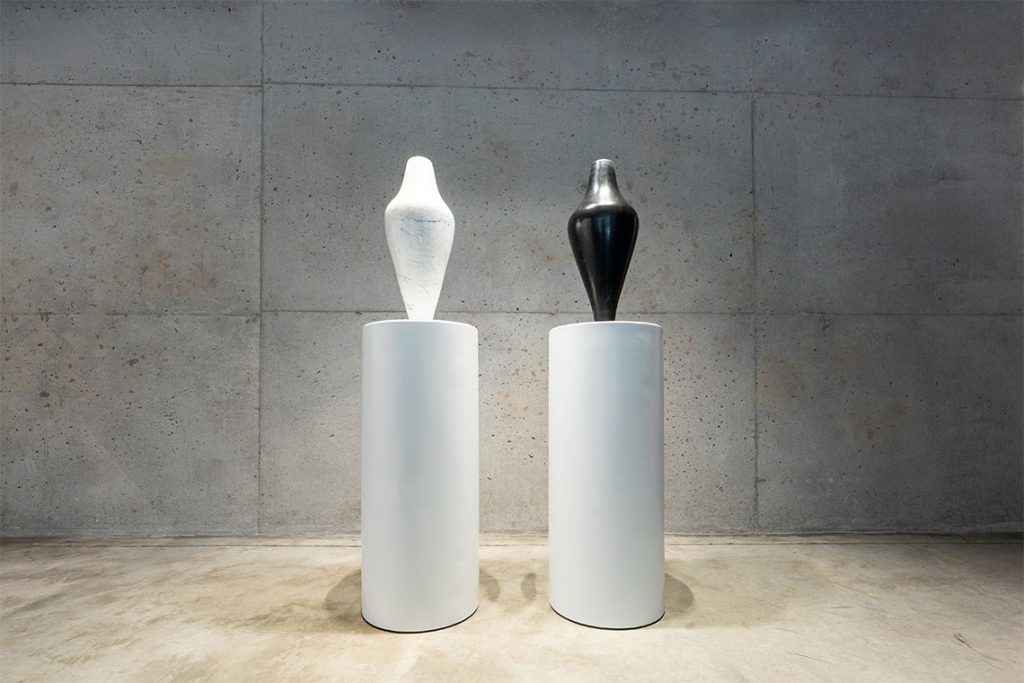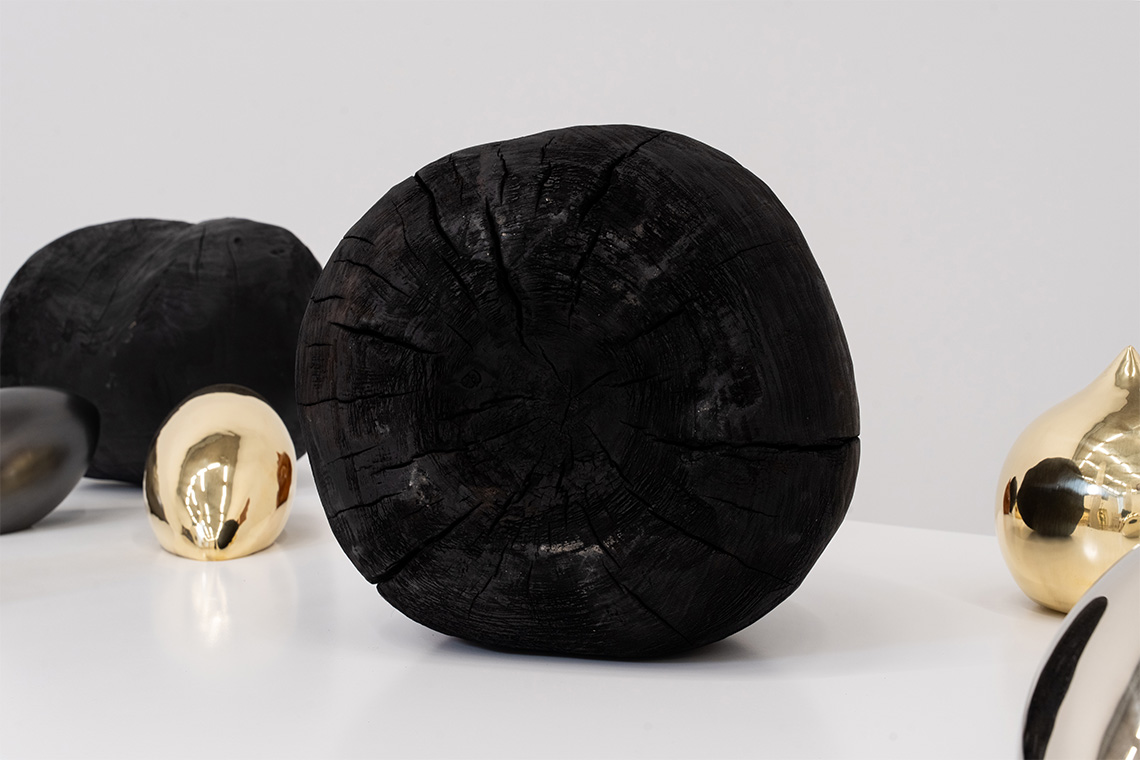Curated by Omar Berrada and Beya Othmani, Les Graines Noires by M’barek Bouhchichi explores Blackness, migration and the multiplicity of lived experience.
According to local legend, Boussaadia was a man from the Sahel whose daughter was abducted and sold into slavery. After searching for her across the desert to no avail, Boussaadia arrived in Tunis, where he began to perform in the streets to earn money. His story, marked by displacement and loss, became central to the healing musical style known as Stambeli in Tunisia.
Saadia, the daughter of Boussaadia, is often overlooked in depictions of the story. Today, M’barek Bouhchichi challenges this narrative in Selma Feriani’s latest exhibition, Les Graines Noires. Upon entering the space, visitors are confronted by two sculptures of her. Saadia (2025) presents two female figurines constructed in black Aziza marble from Tunisia and white Italian Carrara marble. The sloping silhouettes mirror one another, although the dark striations of the white Italian Carrara marble stand in stark contrast to the smooth, supple reflection of the black Aziza. By outlining the tension between the two bodily states, Bouhchichi sets the stage for the exhibition’s central enquiry – how Blackness moves, migrates and is inscribed within wider geographies of representation.
Three sculptures, entitled Boussaadia (2025), explore the legend in more detail. Each piece is formed from charred black wood, its scarred surface shaped around a gaping void. The dark hollow points to the theme of loss, while the distinct shape of each piece resembles guembri, a traditional instrument used in Stambeli music. Stripped of their strings, the disfigured instruments evoke a sense of futility. Visitors are once again reminded that the processes of migration and loss can often rob people of their spirit.

Aspects of ancestral rituals and rootedness are evoked again in I Am Here (2025). The piece features a series of ceramic jars, echoing a tradition from the Zarzis region of Tunisia, where Black communities balance such vessels on dancers’ heads. Rather than balancing them atop a figure, Bouhchichi piles them upon one another precariously, igniting a sense of loss. Etched on the front of each jar are verses from the poem ‘ الحراقة’ (The Burners or ‘Clandestine Migrants’) by M’barek Toumi. The duality of the work comes into sharper focus, revealing both the richness of ancestral dance rituals and the tragic legacy of trans-Saharan displacement.
Another looming tower appears in Palm-Witness (2025), where form once again becomes a study in balance and material tension. Here, twelve half-spheres are piled atop one another. Composed of charred wood, their surfaces are marked by both natural patina and the physical damage of fire. Designed to represent the bark of a palm tree, the pieces seemingly point to themes of destruction and death. In reality, however, the Japanese Shou Sugi Ban method of charring the wood creates a protective layer, improving durability against rot, insects and humidity. Visitors are thus confronted with the realisation that resilience is rarely innate but often shaped – albeit reluctantly – through the weight of shared and individual trauma.
Elements from nature continue to make recurring appearances throughout Les Graines Noires, with imagery from trees drawn upon in Stick Charts 1 (2025) and Stick Charts 2 (2025). Tangled brass casts of branches intersect one another, casting shadows against the wall. The delicate nature of the sticks, broken from the tree, nods to themes of uprootedness and fragility. Drawing on traditional navigation tools and echoing the journeys of those who crossed the Sahara, the seemingly haphazard arrangement of sticks also gestures toward the treacherous realities of migration.

Image courtesy of the artist and Selma Feriani
Bouhchichi’s Vegetal Man (2025), in a similar shimmering brass cast, expands on these themes further. Central to the space, the sculpture consists of three agave stalks. The plant, which dies directly after flowering, sows seeds in its wake – and with them, life begins anew. Ideas of collective survival, sacrifice and transformation are cleverly introduced.
A series of ten drawings, entitled Seedings (2025), is hung behind the sculpture. On rustic paper made from tree bark and recycled textiles, Bouhchichi depicts forms of pre-colonial West African currency. Each image is meticulously composed of tiny, seed-like dots, seemingly evoking unity and collective memory. Yet their arrangement also adeptly signals Bouhchichi’s resistance to the homogenising pressures of marginalisation, with each individual seed reminding viewers of the richness and multiplicity of Black experience.
Two sculptural series, Agave Seeds (2025) and Black Seeds (2025), serve to hammer the point home. Composed of seeds crafted from copper, thuya wood, charred wood and nickel silver or maillechort, the works celebrate multiplicity and transformation. In doing so, the seeds crystallise Bouhchichi’s central message: amidst migration, loss and fragmentation, Blackness cannot be reduced to a single model. Instead, visitors are invited to engage in open interpretation, reflection and a recognition of its living, layered complexity.



